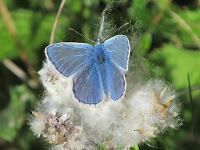Every winter we use
grazing as a habitat management tool on Holy Island in order to open up the
sward of vegetation within the dune system and reduce the impact of non-native
invasive species like Pirri-pirri bur and Michaelmas daisy. However, with funding from the Heritage
Lottery Fund Peregrini Lindisfarne Landscape Partnership project this winter we
have been able to expand the grazing activities on the island.
| Sheep doing a great job grazing the scrub on the Reserve. |
The cattle have now
left the NNR but the sheep are still nibbling away at the vegetation around the
Snook. This winter is seeing the most
extensive grazing ever done on the Snook; the sheep have been out on areas
which have never been grazed before. As
well as grazing on the grasses and non-native species such as Michaelmas daisy,
the sheep have also been having a taste of some small pine and birch trees.
The benefits of this
grazing regime can be seen in the spring and summer months when the wildflowers
begin to bloom. Between May and July
orchids and other dune specialists can be seen flowering in the slacks of the
Holy Island dune system; including Grass-of-Parnassus, pyramidal orchids, marsh
orchid species and the endemic Lindisfarne helleborine.
By increasing the
diversity of wildflowers on the island, day flying moth species like the
Six-Spot Burnet moth and butterfly species such as the dark green fritillary
will also thrive. Other butterfly
species you can look forward to seeing through the summer season include common
blue, small heath, green-veined white, and ringlet – if you look extra hard you
might be able to spot one of the well-camouflaged graylings.
 |
| Grayling. |
 |
| Dark Green Fritillary |



No comments:
Post a Comment